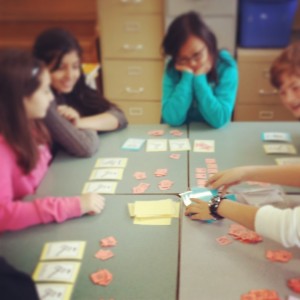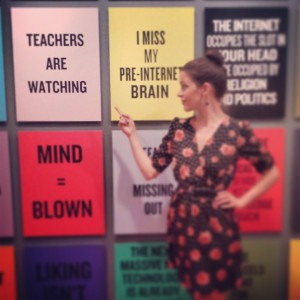Big picture planning
I believe in framing each unit with questions to remind the educator what the aim of the unit is. If what we are doing does not answer the questions, or address the Prescribed Learning Outcomes, the validity of our lessons comes into question.
I believe the unit plans should contain many diverse, enjoyable lessons that cover the learning needs of all the students in the classroom.
I believe in connecting subjects (integrated curriculum) through a core theme or idea. That way, students are connecting ideas to a tangible focus rather than creating separate, abstract ideas.
I believe in creating a personal connection between the student and the subject matter. Does the unit plan explain why this subject is important? Have the students been able to connect their daily lives or interests to the unit? Have I discovered a personal interest in the subject so that I can teach it with a passion?
Examples
Below are examples of unit plans used during my practicum (available for public use):
Unit Plan – SS Ancient Greece Unit Plan – H.A.C.E. Media & Smoking
Unit Plan – LA Greek Mythology Unit Plan – Math 6 Transformations
Development
During my practicum, I found it was difficult to incorporate all the learning styles into my unit plans. To further develop myself as a teacher, I would like to focus on creating unit plans that address the learning needs of each of my students.
I am also working on using technology to create engaging units that incorporate inquiry based learning, where students can use technology to explore topics within the units that are of interest to them. The logistics of motivation and the guidelines for such projects are still in the developmental stage for me.
More detailed planning
I believe in beginning lessons with a story, video clip, interesting fact, or current event that relates to the daily topic. I like to use a ‘hook’ because it provides students with a soft transition from one subject to another without overwhelming them, while piquing their curiosity.
I believe in providing as many opportunities as possible for students to make choices about where they want to learn, what they want to learn, and how they want to learn. Teaching students Self-Regulation strategies empowers them as learners and provides more opportunities for students to become passionate about their learning.
I believe in being mindful of students with exceptionalities and preparing adaptations so that they may participate in the classroom in a meaningful way and learn to the best of their abilities.
I believe in scaffolding my students before sending them out to complete the tasks assigned. My formal lessons during my practicum used an “I-do-we-do-you-do” method of sharing information with my students.
I believe students should have the opportunity to share their ideas with others and engage in critical thinking and debate. In the examples of my worksheets below, there is a ‘critical thinking’ question for students to delve deeper into the subject and make connections. Often, we would get together in a circle and each student had the opportunity to share their answer to the critical question.
Examples
Examples of worksheets I made for my Social Studies unit (available for public use):
01 – Physical Geography of Greece 02 – Agriculture in Ancient Greece
One of my favorite resources I created was a card game for my students to learn more about the combination of the economic system used by the Ancient Greeks. The students loved the game, and were able to make interesting connections back to the content during our group discussions. One of my favorite parts about watching them play the game, was how they worked together to understand the rules, as well as made their own rules for the game.
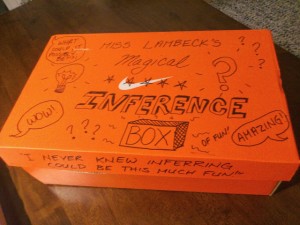 One of the more difficult concepts I taught my practicum class was the notion of inference. Along with lessons, activities, examples, and games, I created an “Inference Box” that students could reach their hands into and through feeling, infer what was inside.
One of the more difficult concepts I taught my practicum class was the notion of inference. Along with lessons, activities, examples, and games, I created an “Inference Box” that students could reach their hands into and through feeling, infer what was inside.
![20140606_153037[1]](https://blogs.ubc.ca/lambeck/files/2014/02/20140606_1530371-300x168.jpg) To introduce the idea of inquiry based learning, I had my students choose a piece of art they would like to present to the rest of the class. Later, we placed “fact sheets” of each students’ chosen art on a timeline and discussed the themes and patterns we saw throughout time, as well as how political aspects of each era affected the artistic styles.
To introduce the idea of inquiry based learning, I had my students choose a piece of art they would like to present to the rest of the class. Later, we placed “fact sheets” of each students’ chosen art on a timeline and discussed the themes and patterns we saw throughout time, as well as how political aspects of each era affected the artistic styles.
Development
When it comes to planning and presenting lessons, one of my greatest areas of development was transitioning. I used wait time and made sure to keep a connection between one topic and another to improve myself as an educator.
I am consistently searching for new content and resources to make my lessons more exciting for students. How can I incorporate various media into my lessons in a meaningful way?
I am interested in learning more about how to make use of flipped classroom principles. I think it is a great way to free up time in the classroom for more meaningful practices such as critical thinking activities, demonstrations, and experiments.
Assessment
Beliefs
I believe students should be involved in the assessment process so that they may have the opportunity to highlight portions of the assignment they are pleased with.
I believe in keeping in mind students with exceptionalities and creating ways for them to demonstrate their knowledge to the best of their ability.
I believe in providing clear, concise instructions and assessment criteria. Before a student begins a project, the objectives and details should be made clear to each student.
I believe students should be involved in creating the evaluation criteria, and there should be a choice of how the students wish to be evaluated (poster project, testing, oral presentation, etc).
I believe criteria should relate back to the objectives and learning goals, while providing the student with an easy way of demonstrating their knowledge of the subject, rather than an unrelated subject areas.
Examples
![20140606_153057[1]](https://blogs.ubc.ca/lambeck/files/2014/02/20140606_1530571-300x168.jpg)
For the summative assessment in the Math 6: Transformative Geometry unit, I provided the students with an option of demonstrating the various transformations with an art project.
I created an assessment template that combines a check list and an area for comments about what the student did well or could improve on for both the teacher and the student to complete. The focus of this tool is for students to use assessment as learning, while I use the checkboxes for assessment of learning and the comments as formative assessment for learning. The comments provide a space for both the student and the educator to acknowledge the strong points of the assignment, as well as where there is room for further development. (Assessment template example)
Development
I have learnt a lot about using a wide variety of assessment tools, rather than the standard writing assignment and test combination. I am still searching out innovative, fun ideas for students to show me their learning.
I want to learn more about fair, valid modes of assessing students’ work that has come from an adapted or modified assignment.
I want to improve on involving students in the criteria building and assessment process. It is important to me that they realize the importance of valuing their academic success.
Class management & behavior
Beliefs
I believe the entire class should not be punished for the behavior of a single student. Rather, the punishment for a student’s disruptive behavior should be an action which benefits the rest of the class.
I believe a strong class community and student-teacher relationship can prevent many class management issues.
I believe students should be able to Self-Regulate their behavior and adapt their surroundings to prevent outbursts or disruptions.
Examples
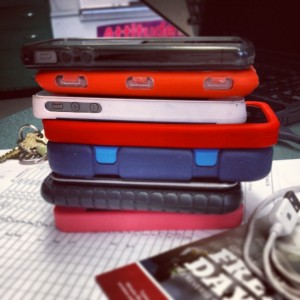 One of the greatest assets to the world of education is the introduction of personal technological devices into the classroom. The access to information and resources is a great gift, that comes with many classroom management issues. Students can be tempted to distract themselves with games and texting during classes, or cheating during tests. During my practicum, I found that clear guidelines were important so that confiscations (such as the one in the photo) did not have to take place. A safe place for students to keep their devices while they were not needed worked well to prevent students from getting tempted to use them. More serious issues can occur when students use social media inappropriately. Teaching students the importance of protecting their digital footprint and respecting others is a great life lesson for every student.
One of the greatest assets to the world of education is the introduction of personal technological devices into the classroom. The access to information and resources is a great gift, that comes with many classroom management issues. Students can be tempted to distract themselves with games and texting during classes, or cheating during tests. During my practicum, I found that clear guidelines were important so that confiscations (such as the one in the photo) did not have to take place. A safe place for students to keep their devices while they were not needed worked well to prevent students from getting tempted to use them. More serious issues can occur when students use social media inappropriately. Teaching students the importance of protecting their digital footprint and respecting others is a great life lesson for every student.
My practicum class had a wonderful sense of community, which led to a noisy, energetic classroom. One of my daily routines was to use the SmartBoard to communicate with my class. When the students came in, there was a step-by-step list of what I wanted my students to do when they came into the classroom. During times such as tests or silent reading, wen students were expected not to talk, I would write their name on the boards, instead of disrupting the class by verbally reminding them. The students who had their names on the board would repay the class back for their disruption by cleaning up the class, or putting everyone’s chairs away at the end of class.
A strong teacher presence is an excellent way of preventing classroom management issues. Being aware of the social dynamic of the classroom structure is important for every teacher. One of the most useful practices I did during my practicum was to ask students to write who they would like to sit next to, and who they would not work well with for an upcoming seating configuration. This exercise provided me with insight into who may need to develop their social skills or be at risk for bullying.
Development
I am still working on the balance between creating meaningful interactions with my students while still maintaining the level of respect necessary as a teacher.
I have spent a lot of time during my practicum trying to find ways of communicating why a particular rule is in place and its importance.
I want to learn more about community building strategies to motivate students to work together and prevent issues from arising. I also want to work on having the students being involved in classroom management.
Building community in the class & beyond
Beliefs
I believe students should be given to opportunities to become influential members of their community through community service.
I believe students learn best when they are able to collaborate and refine their ideas through meaningful conversation.
I believe it is the teacher’s responsibility to refine socializing skills so that students can work together more effectively.
Examples
My favorite community building exercise we did with my class were passion projects,where students presented about their passions with the rest of the class. I think the more students know about their classmates, the more they empathize and connect with one another. I think when students are able to show what they are great at, or have a lot of knowledge about, they can be used as a resource for the rest of the class. As a part of my strong belief for respecting students, I believe in involving students and inviting them to share their expertise.
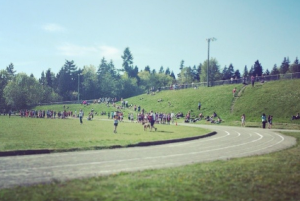 When I was in high school, I was very shy and often felt overwhelmed in such a big school. In grade 9 I joined Students’ Council and felt as if I were a part of the school community. As I continued growing my leadership skills in Students’ Council, my confidence and social skills grew. I am looking forward to being able to facilitate such groups so that other students can experience being a part of the school outside of class. During my practicum, I volunteered to coach the Track and Field teams and I really enjoyed getting to know students outside class. The sense of purpose and motivation students who partake in such activities showed me how important it is for students to have such opportunities.
When I was in high school, I was very shy and often felt overwhelmed in such a big school. In grade 9 I joined Students’ Council and felt as if I were a part of the school community. As I continued growing my leadership skills in Students’ Council, my confidence and social skills grew. I am looking forward to being able to facilitate such groups so that other students can experience being a part of the school outside of class. During my practicum, I volunteered to coach the Track and Field teams and I really enjoyed getting to know students outside class. The sense of purpose and motivation students who partake in such activities showed me how important it is for students to have such opportunities.
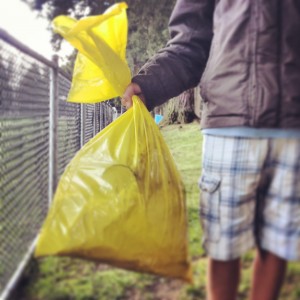 During my practicum, my class collected garbage around the neighborhood as a part of their Random Acts of Kindness. What spoke to me is how much the students enjoyed the activity, especially those student who do not usually enjoy typical classroom learning environments. When the students saw the results of their efforts, they were very proud of the difference they made in their community. During my discussion with the students after, they mentioned how they would think twice before littering, now that they knew how much work it takes to clean a park. I think such acts can be infused into the conventional curriculum. For example, when learning about patterns or statistics, ecology, scientific method, art, literature and current events.
During my practicum, my class collected garbage around the neighborhood as a part of their Random Acts of Kindness. What spoke to me is how much the students enjoyed the activity, especially those student who do not usually enjoy typical classroom learning environments. When the students saw the results of their efforts, they were very proud of the difference they made in their community. During my discussion with the students after, they mentioned how they would think twice before littering, now that they knew how much work it takes to clean a park. I think such acts can be infused into the conventional curriculum. For example, when learning about patterns or statistics, ecology, scientific method, art, literature and current events.
Development
I would like to find more ways of integrating the local community into my classroom lessons.
I am interested in learning more about classroom community building strategies that are applicable for each age group, that student will buy into.
I worked very hard during my practicum to discover where I fit in as the teacher in the classroom community and how I can add to the group dynamic.
Collaborative ability
Beliefs
I believe in setting an example to my students by collaborating with colleagues through sharing ideas and resources.
I believe in shifting away from the competitive academic attitude of traditional pedagogy and moving into a practice that values teamwork and collaboration.
I believe that a strong focus on collaboration prepares students for careers and instances where they will have to work in team environments in the future.
Examples
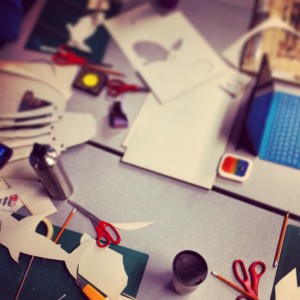 One of the learning strategies I taught my students was how to collaboratively learn with a Jigsaw activity. What I like about jigsaws are how students are able to learn from one another and learn how to effectively transmit knowledge to their peers. I found this activity to be effective method of developing group learning as well as speaking and listening skills. Collaborative art projects are fun, low-stress activities that can be used to teach students how to work with others. Debates and Think-Pair-Share activities are other strategies I used to promote a collaborative learning environment.
One of the learning strategies I taught my students was how to collaboratively learn with a Jigsaw activity. What I like about jigsaws are how students are able to learn from one another and learn how to effectively transmit knowledge to their peers. I found this activity to be effective method of developing group learning as well as speaking and listening skills. Collaborative art projects are fun, low-stress activities that can be used to teach students how to work with others. Debates and Think-Pair-Share activities are other strategies I used to promote a collaborative learning environment.
My program at the University of British Columbia actively develops collaboration skills within its Teacher Candidates. Never before in my education have I had so many opportunities to develop ideas, work on projects, and research in an environment completely focused on benefiting the entire group. This classroom dynamic has taught me that resources and ideas are meant to be shared. Especially in the teaching profession, where you know that helping one another ultimately benefits the students. I was fortunate enough to continue this experience within my practicum school, where teachers were in Teams, which met weekly to discuss and problem solve. Within the teams, each teacher had a partner teacher that they would work closely with to create effective unit and lesson plans.
Development
I am interested in finding more ways to develop collaboration skills for my students. I am in the process of researching and brainstorming activities that can include all members of a group.
I worked with many other teachers and members of the school, and I would like to continue to find a place where I can hone my skills of collaboration within the teaching profession.
I want to continue to build bonds with museums, members of the public, and other resources I can bring into my classroom. I would like to create mutual beneficial experiences through exchange of resources for community service or other exchanges.

